
Homogeneous Catalysis
.pdf
METALLOCENE CATALYSTS |
115 |
The following points need to be made. First, the five-membered ring may also be a part of an indenyl ring structure, and the two five-membered rings may be indenyl ligands or one may be an indenyl while the other is a cyclopentadineyl ring. Second, the metal (M) is titanium or zirconium in the oxidation state of four. Third, A is an optional bridging atom, generally a carbon or silicon atom with R—CH3, H, alkyl, or other hydrocarbon groups. The Rs on A and on the five-membered rings need not necessarily be the same. Finally, X is usually Cl or an alkyl group. Two typical examples of this type of catalyst are shown by structures 6.22 and 6.23. As we shall see later, the structural difference in terms of symmetry between 6.22 and 6.23 has an important bearing on the tacticity of polypropylene produced by these catalysts.
Monocyclopentadienyl complexes have also been used as active polymerization catalysts. Indeed, titanium monocyclopentadienyl metallocenes—the socalled “constrained geometry catalysts”—have been focal points of Dow’s activity in this area. A typical example of such a catalyst is shown by the structure 6.24.
As mentioned earlier, the soluble metallocene catalysts exhibit high polymerization activities only in combination with water and Me3Al. The reaction

116 POLYMERIZATION
between Me3Al and water generates methyl aluminoxanes (MAO), which are the actual active co-catalysts. The function of these co-catalysts is the generation of a coordinatively unsaturated catalytic intermediate. This is shown schematically in Fig. 6.6.
Here MAO first generates the dimethyl complex 6.26 from 6.25. This reaction, of course, can also be brought about by Me3Al. It is the subsequent reaction (i.e., the conversion of 6.26 to 6.27 that is of crucial importance. The high Lewis acidity of the aluminum centers in MAO enables it to abstract a CH3 group from 6.26 and sequesters it in the anion, [CH3-MAO] . Although 6.27 is shown as ionically dissociated species, probably the anion, [CH3- MAO] , weakly coordinates to the zirconium atom. It is this coordinatively unsaturated species, 6.27, that promotes the alkene coordination and insertion that are necessary for polymerization activity.
The general formula of MAO is given by Me2Al-O-[AlMe]n-OAlMe2, where n is between 5 and 20. Controlled hydrolysis of AlMe3 produces a mixture of such oligomers. The solution structures of these oligomers have been investigated by a variety of spectroscopic and other techniques, including 27Al NMR. From such studies intramolecular 3-O bridges between three aluminum atoms 6.28, and 2-CH3 bridges between two aluminum atoms 6.29, have been identified.
Also present are both fourand three-coordinate Al centers, the latter probably giving rise to high Lewis acidity. Structures of some aluminoxane clusters have also been determined in the solid state by single-crystal X-ray studies. One such structure, that of [Al7O6Me16] anion, is shown by 6.30. Another structure, 6.31, has been proposed on the basis of mass spectroscopic data. All the evidences taken together point to open-cage rather than dense mineral structures for the aluminoxanes in MAO solutions.

Figure 6.6 Production of active catalyst 6.27 from the precatalyst 6.25 by treatment with methyl alumino oxane. 6.26 does not have free coordination site and cannot act as a catalyst.
117
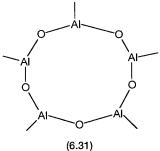
118 POLYMERIZATION
6.5.2Special Features and Advantages of Metallocene Catalysts
The mechanical, thermal, optical, and other properties of a polymer depend on the structure of the monomer units. Where a copolymer is used, it depends additionally on the relative amounts and distribution of the two monomeric building blocks. Metallocene catalysts have four main advantages over the conventional polymerization catalysts. They can polymerize a very wide variety of vinyl monomers irrespective of their molecular weights and steric features. They also can polymerize mixtures of monomers to give polymers of unique properties.
The second advantage of a metallocene catalyst is the advantage of the single site. Microcrystalline Ziegler–Natta catalyst, with nonidentical coordination environments around the catalytically active metal centers, give polymers with broad molecular-weight distributions. Metallocene catalysts, on the other hand, produce extremely uniform homopolymers and co-polymers. This is because every molecule of the metallocene catalyst has an identical coordination environment and therefore produces identical or nearly identical polymer chains. If a broad molecular-weight distribution is desired, that can be achieved with high precision by using more than one catalyst and/or cascade reactor configurations. In the latter case different reactors are operated under different conditions to produce polymers of different molecular weights.
The third advantage associated with metallocene catalysts is that the predominant mechanism for chain termination is by -hydride elimination. This produces a vinyl double bond at the end of each polymer chain. Further functionalization of the vinyl group by graft polymerization with maleic anhydride and other functional monomers is far more effective than is typical for polyolefins obtained by conventional catalysts.
Finally, the most important feature of the metallocene catalysts is their ability to produce highly stereoregular polymers. The molecular geometry of the metallocene molecule directly controls the stereoregularity of the resultant polymer. By the correct choice of ligand environment it is possible to generate highly stereoregular polypropylene or polystyrene. Indeed, syndiotactic polystyrene and other aromatic polymers are a new class of materials made available only by metallocene catalysts.
METALLOCENE CATALYSTS |
119 |
6.5.3 Mechanism of Polymerization and Stereocontrol by Metallocene Catalysts
The basic mechanism of metallocene-based polymerization involves a catalytic cycle very similar to that of Fig. 6.5. The precatalysts 6.22 and 6.23, in combination with MAO, produce polypropylene of high isotacticity and syndiotacticity, respectively. As shown in Fig. 6.7, 6.22 has C2 symmetry and is chiral, while the symmetry of 6.23 is Cs and is therefore achiral. Two points need to be noted before we discuss the mechanism of stereospecific insertion of propylene. First, propylene is a planar molecule that has two potentially nonequivalent, prochiral faces (see Section 9.3.1). Second, the symmetry around the metal atom determines whether or not coordinations by the two faces of propylene are equivalent.
The mechanism of stereocontrol has been investigated by a variety of techniques. These include 13C NMR, molecular mechanics, ab initio calculations, and kinetic studies with deuterium-labeled alkenes. From these studies the following conclusions can be drawn. First, the process of stereocontrol begins only after the growing polymer chain acquires at least two carbon atoms. For a chiral catalyst like 6.22, every single molecule of propylene coordinates to the metal atom only through one specific prochiral face, and not the other one. Second, the metal alkyl chain favors an orientation where its C( )–C( ) segment is in the most open sector of the metallocene catalyst. In this orientation the substituent on the alkene (i.e., the methyl group of the coordinated propylene molecule) is trans to the -carbon atom of the metal bound alkyl chain. In other words, it is as far away from the alkyl chain as possible. This is shown schematically in Fig. 6.8. Finally, as mentioned earlier (see Section 6.4.2), the transition state is stabilized by an -agostic interaction. Note that in the absence of agostic interaction rotation around the Zr—C bond would cause the trans orientation between the methyl substituent of propylene and (P) of the growing polymer chain to be lost.
Two examples clearly illustrate the relationship between molecular structures of the metallocene catalysts on the one hand, and the tacticity of the resultant polymers on the other. As shown in Fig. 6.9, complexes 6.32, 6.33, and 6.34 have very similar structures. In 6.33 and 6.34 the cyclopentadiene ring of 6.32 has been substituted with a methyl and a t-butyl group, respectively. The effect of this substitution on the tacticity of the polypropylene is remarkable. As already mentioned, 6.32, which has Cs symmetry, gives a syndiotactic polymer. In 6.33 the symmetry is lost and the chirality of the catalyst is reflected in the hemi-isotacticity of the polymer, where every alternate methyl has a random orientation. In other words, the insertion of every alternate propylene molecule is stereospecific and has an isotactic relationship. In 6.34 the more bulky t- butyl group ensures that every propylene molecule inserts in a stereospecific manner and the resultant polymer is fully isotactic.
The second example uses a precatalyst that has a temperature-dependent equilibrium between two structures—one chiral and the other achiral. This is
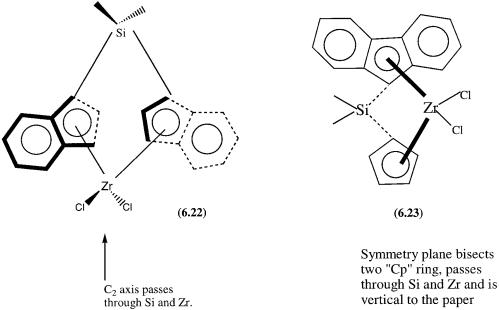
120
Figure 6.7 Schematic presentation of metallocene catalysts of C2 and Cs symmetry. The dark and broken lines represent above and below the paper.
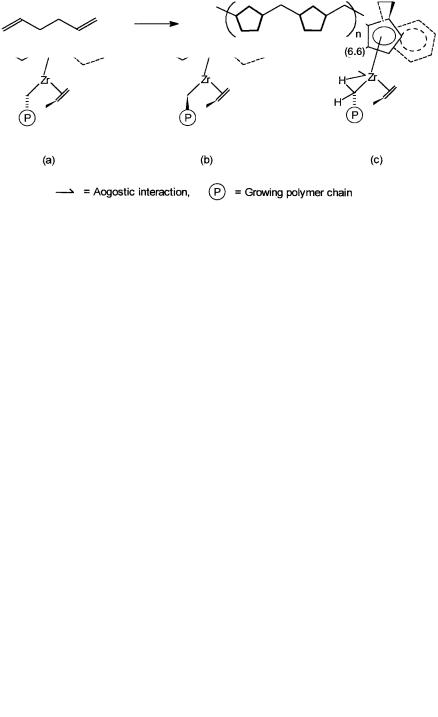
METALLOCENE CATALYSTS |
121 |
Figure 6.8 Stereospecific propylene insertion in a metallocene catalyst of the type 6.22. For clarity the coordination of Zr to the second indene ring (broken line) is not shown. (a) Preferred orientation of the growing polymer chain. Note the trans orientation of the methyl group (above the plane of paper) and P (below the plane of paper). (b) Rotation along the Zr—C bond may make P and CH3 cis to each other.
(c) Agostic interaction that prevents rotation around the Zr—C bond and keeps P and CH3 away from each other.
shown in Fig. 6.10. The use of this precatalyst in combination with MAO produces polypropylene with blocks of “isotactic” and “atactic” fragments. The relative amount of such blocks is determined by the relative amounts of 6.35 and 6.36 that are present at a given temperature.
Note that at lower temperatures the amount of 6.36 present would be less compared with 6.35. This is because of the “eclipsed” structure of 6.36, which has higher nonbonded interactions than that of 6.35. The net effect of this is that at lower temperatures more isotactic blocks are formed. Thus the resultant polymer shows a higher degree of isotacticity than that of polymers formed at ambient or higher temperatures.
Finally, as already mentioned, metallocene catalysts can polymerize a variety of olefins. In certain cases the structural features of the monomer lead to the formation of novel polymers. Two such examples are shown by reactions 6.6 and 6.7. It is clear that the polymerization processes involve considerable rearrangements of the bonds. Reactions 6.8 and 6.9 show the formal mechanisms of such rearrangements for 1,5-hexadiene and methylenecyclobutane, respectively.
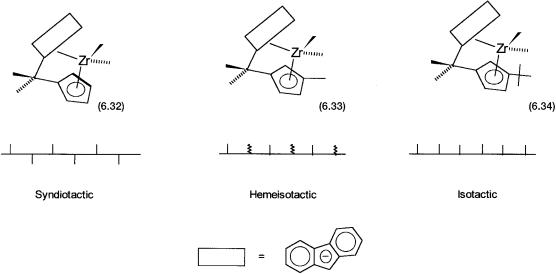
122
Figure 6.9 Effect of symmetry and substituents on the stereochemistry of the resultant polypropylene. 6.32 has Cs symmetry. 6.33 is chiral, but the effect of Me is moderate. 6.34 is also chiral, and the effect of bulky But is more marked.
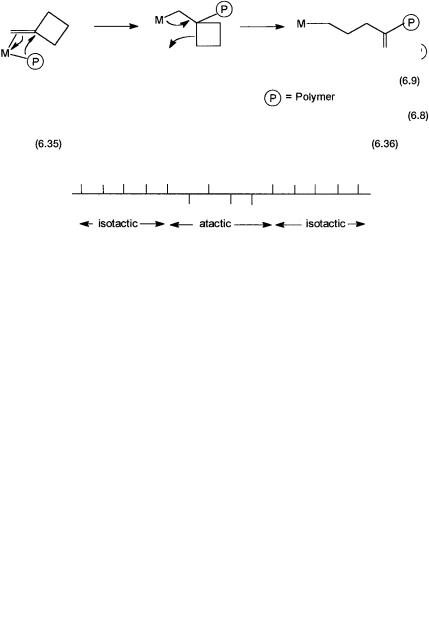
CHROMOCENE AND HETEROGENEOUS CATALYSTS |
123 |
Figure 6.10 Temperature-dependent equilibrium between chiral and achiral isomers of a metallocene catalyst and the resultant polypropylene with isotactic and atactic polymer-blocks.
6.6CHROMOCENE AND HETEROGENEOUS CATALYSTS
In Section 6.2, it was mentioned that one of the commercial catalysts for polyethylene (HDPE) is made by the reaction of chromocene with silica according
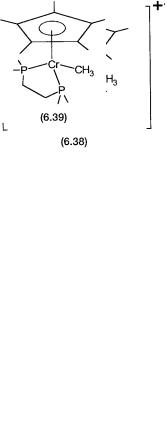
124 POLYMERIZATION
to reaction 6.1. The oxidation state of the catalytically actives sites has been the subject matter of some debate. Recent experiments with well defined homogeneous cyclopentadiene chromium complexes, 6.37–6.39, strongly suggest that the oxidation state of chromium in this catalyst is 3 rather than 2 .
Complex 6.37 has been shown to be an active catalyst for the manufacture of HDPE. Note that 6.37 is a 15-electron complex with chromium in the formal oxidation state of 3 . The mechanism of polymerization involves generation of coordinative unsaturation through the dissociation of a THF molecule from 6.37. The evidence for an oxidation state of 3 in the commercial catalyst comes from the fact that complex 6.38 is active for polymerization. However, complex 6.39, identical to 6.38 in every respect except the oxidation state of the metal ion, is inactive. Note that the oxidation state of chromium in 6.39 is 2 .
